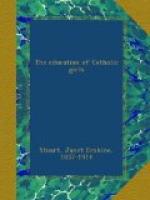The present Cardinal Archbishop of Westminster, when rector of St. John’s Seminary, Wonersh, used to lay down the following rules for his students, and on condition of their adhering to these rules he allowed them great freedom in their reading, but if they were disregarded, it was understood that the rector took no responsibility about the books they read:—
1. “Be perfectly conscientious, and if you find a book is doing you harm stop reading it at once. If you know you cannot stop you must be most careful not to read anything you don’t know about.”
2. “Be perfectly frank with your confessor and other superiors. Don’t keep anything hidden from them.”
3. “Don’t recommend books to others which, although they may do no harm to you, might do harm to them.”
These rules are very short but they call for a great deal of self-control, frankness, and discretion. They set up an inward standard for the conscience, and, if honestly followed, they answer in practice any difficulty that is likely to arise as to choice of reading. [1—In the Appendix will be found a pastoral letter by Cardinal Bourne, Archbishop of Westminster, then Bishop of Southwark, bearing on this subject and full of instruction for all who have to deal with it.]
But the application of these rules presupposes a degree of judgment and self-restraint which are hardly to be found in girls of school-room years, and before they can adjust themselves to the relative standard and use the curb for themselves, it is necessary to set before them some fixed rules by which to judge. While life is young and character plastic and personal valuations still in formation, the difficulty is to know what is harmful. “How am I to know,” such a one may ask, “whether what seems harmful to me may not be really a gain, giving me a richer life, a greater expansion of spirit, a more independent and human character? May not this effect which I take to be harm, be no more than necessary growing pains; may it not be bringing me into truer relation with life as it is, and as a whole?”




